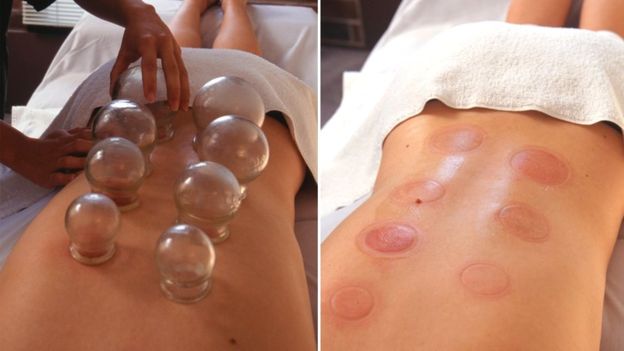A lot of people noticed strange purple circles covering Michael Phelps’ shoulders when he got to the water to swim in the 4×100-meter relay at the Olympics on Sunday. He got these purple circles from the latest alternative therapy for faster recovery and better performance of elite athletes, called cupping.
However, the science is rather inconclusive when it comes to this and many other alternative therapies, suggesting that you might not need to try it out on your sore muscles right away.
Cupping Originates from the Traditional Eastern Medicine
Phelps’ personal trainer placed plastic or glass vacuum cups on his skin, which left marks on his shoulders in the form of purple circles. The tools required for this practice are a vacuum pump and glass or plastic cups. It’s actually very simple. An area of vacuum pressure is created when you place the cups over the muscles and use the vacuum pump. Blood is drawn to the surface and there are broken capillaries which cause the formation of purple circles on the top of the skin.
Sometimes, cupping practitioners use heated cups instead of a vacuum pump. As they cool, the air inside the cups contracts, creating the negative pressure which actually brings blood to the skin’s surface. This alternative therapy has been used in ancient Chinese medicine and in the Middle East for centuries.
According to Chinese medicine practitioners, cupping helps VOX, or as they call it, channels of qi. As athletes say, this ancient therapy helps blood flow, recovery, and healing, and reduces pain.
There’s a photo on Phelps’ Instagram that was taken about a year ago, which shows he is doing this practice ever since then. Besides Phelps, another American athlete who noticed purple circles on his skin is the gymnast Alexander Naddour.
Cupping Appears to Be Safe. However, does It Work?
Meta-researchers have done a few systematic reviews of the scientific material obtained by studies on cupping. Researchers use these reviews to understand what the basics of the evidence are, as some studies tend to exaggerate effects or have design flaws.
According to the systematic reviews, cupping isn’t harmful, but the studies on this practice are too weak to come to strong conclusions if it’s really effective.
In 2010, BMC Complementary and Alternative Medicine published one such systematic review which included 550 clinical studies. 78.1 percent of them were at high risk of bias. The review also concluded that there’s no standard method to measure the effectiveness of cupping. It suggests that this alternative therapy can’t be recommended for clinical use as there isn’t sufficient evidence.
 In 2012 PLOS One released another review that analyzed 135 studies. It also didn’t end up with any evidence that this therapy is effective, but it was for specific uses such as acne, shingles, cervical spondylosis (degradation of spinal disks in the neck that appears with aging), and facial paralysis. All these conditions don’t influence the performance of athletes.
In 2012 PLOS One released another review that analyzed 135 studies. It also didn’t end up with any evidence that this therapy is effective, but it was for specific uses such as acne, shingles, cervical spondylosis (degradation of spinal disks in the neck that appears with aging), and facial paralysis. All these conditions don’t influence the performance of athletes.
In 2015, the Journal of Traditional Chinese Medical Sciences reported a Vox on cupping, which indicates that the mechanism of this therapy for pain is still unclear. So if researchers don’t know what’s going on, they can’t know the precise variables that need to be closely analyzed.
One guess is that this method brings blood to an area, which actually promotes healing. According to others, pulling the muscles upwards relieves stress in them. The 2015 review indicates that the therapeutic efficacy of this alternative therapy needs to be validated by larger and well-designed studies. As it seems, there’s no evidence that cupping heals, but also there’s no evidence that it disapproves of its efficacy. Meanwhile, we have famous athletes to propel cupping forward.
The One Certain Way Cupping Can Help Is the Placebo Effect
Athletes tend to be very superstitious. If they try something new, like wearing an “energy” bracelet, performing some ritual, or doing cupping, and get good results, they might be scared to stop this “happy” habit believing they won’t get the same positive results the next time they perform. According to studies, these superstitions can calm their minds and help them stay confident in their capacity.
And as cupping didn’t prove to be harmful, it won’t be the worst thing.
Via Vox
